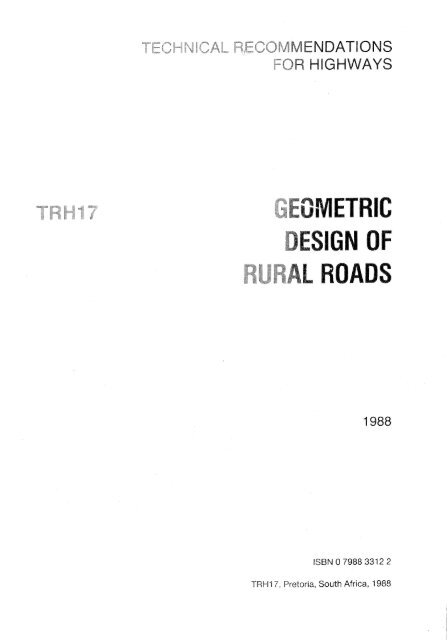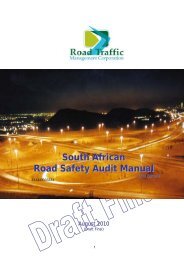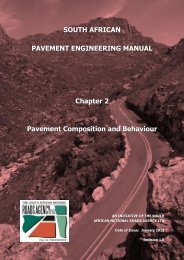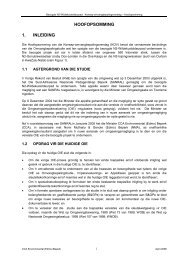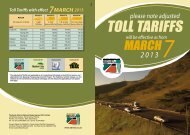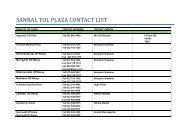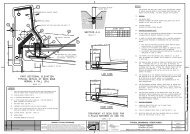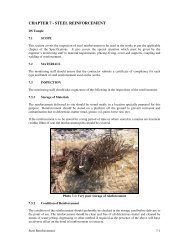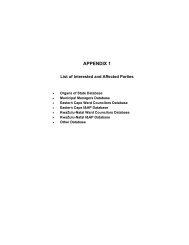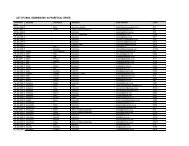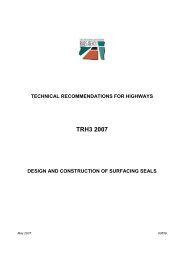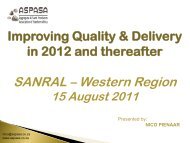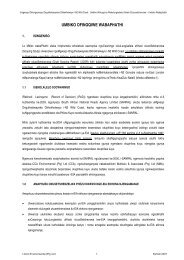TRH17 (1988) Geometric Design of Rural Roads
TRH17 (1988) Geometric Design of Rural Roads
TRH17 (1988) Geometric Design of Rural Roads
- TAGS
- geometric
- rural
- roads
- www.nra.co.za
You also want an ePaper? Increase the reach of your titles
YUMPU automatically turns print PDFs into web optimized ePapers that Google loves.
0'798833122<br />
retoria, South Africa, 198%
<strong>Geometric</strong> des~gn<br />
TRHI 7, Pretoria, South Africa, <strong>1988</strong>
n <strong>of</strong> surfaced rural roa<br />
on the geometric desi n manuals <strong>of</strong><br />
ic parameters <strong>of</strong> driver, vehicle<br />
to horizontal and vertical ali<br />
design <strong>of</strong> intersections<br />
ion is paid to drainage ele-<br />
ntwerp van buitestedelike dek-<br />
gebaseer op die han<br />
it in die basiese parameters van<br />
ord riglyne wat betrekking<br />
elei. Die ligging en ont-<br />
eskenk aan dreine-<br />
nment, cross-sec<br />
<strong>Geometric</strong> design<br />
<strong>TRH17</strong>, Pretoria, South Africa, <strong>1988</strong>
The geometric desi<br />
ere derived lar<br />
e years, however<br />
by the various a<br />
The Committee o<br />
practice will be <strong>of</strong><br />
creasingly mobile<br />
for practice to be<br />
tions. It has therefore<br />
evance should be<br />
H1 7 represents the a<br />
<strong>TRH17</strong> is base<br />
statements on<br />
The wide variety<br />
TRH1 7 therefor<br />
The Committee res<br />
resentatives <strong>of</strong> the<br />
<strong>Geometric</strong> design<br />
TRH 1 7, Pretoria, South Africa, <strong>1988</strong>
cope <strong>of</strong> the document<br />
7 3 Traffic volumes<br />
1.4 Traffic speed<br />
7 Capacity and level <strong>of</strong> service<br />
I. Classification <strong>of</strong> rural roads<br />
2. "i<br />
The driver<br />
e road surface<br />
kt distance<br />
uccessive curves<br />
<strong>Geometric</strong> design<br />
YRHI 7, Pretoria, South Africa, <strong>1988</strong>
<strong>Geometric</strong> design<br />
<strong>TRH17</strong>, Pretoria, South Africa, <strong>1988</strong>
<strong>Geometric</strong> design<br />
<strong>TRH17</strong>, Pretoria, S ~uth Africa, <strong>1988</strong>
Gsnmelric de?lsiign<br />
TRH 1 7. Pretoria, South Africa, 1
nents <strong>of</strong> the four<br />
rmity <strong>of</strong> geometry<br />
current practices and standards. The<br />
endment as research results, tailorin<br />
F the conse-<br />
<strong>Geometric</strong> design<br />
TWHf 7, Pretoria, South Africa, <strong>1988</strong> 1
The design <strong>of</strong> new routes or improvements to existing route<br />
traffic vo!umes. A design life <strong>of</strong> 20 years is <strong>of</strong>ten<br />
eriod may be altered subject to the planning <strong>of</strong><br />
cerned, and the evaluation <strong>of</strong> the economic consequences <strong>of</strong><br />
suggested timespan. For example, a relatively low-cost road<br />
volumes may justify a shorter design life because <strong>of</strong> the sa<br />
er number <strong>of</strong> axle-load repetitions in the shorter pe<br />
hilly or mountainous terrain may require a longer design li<br />
sonable return on the initial cost <strong>of</strong> construction.<br />
Projected traffic volumes should prefera<br />
growth factor to present-day traffic coun re an alternative<br />
able, an origin-destination survey may be nec<br />
possible alternatives, a full-scale transporfation<br />
ered. A useful input to the determination <strong>of</strong> proj<br />
Traffic Demand Model administered by the Department <strong>of</strong> Tran<br />
Traffic volumes are <strong>of</strong>ten e essed in terms <strong>of</strong> average dail<br />
sured in vehicles per day. ADT does no<br />
hourly fluctuations in traffic volume.<br />
frequently assumed to be the 30th<br />
n, ie the hourly volume exceeded<br />
hourly volume is expressed as a<br />
tween 12 and 18 per cent. A figur<br />
mally assumed unless actual counting suggests an<br />
nual basis, the directional split on most rural roads i<br />
ever, during any specific hour the volume in one direction may<br />
than in the other. The directional split is <strong>of</strong>ten in the ratio o<br />
heavier flow is the design criterion.<br />
Traffic speeds are me kilometres per hour.
<strong>Geometric</strong> design<br />
W 1 7, Pretoria, South Africa, <strong>1988</strong><br />
is affects visi
<strong>Geometric</strong> design<br />
TRM4 7, Pretoria, South Africa, <strong>1988</strong>
<strong>Geometric</strong> design<br />
<strong>TRH17</strong>, Pretoria, South Africa, <strong>1988</strong>
Traffic volumes ve
iscusses the parameters from se guidelines are derive<br />
the design vehicle, its dimen performance characteri<br />
ssary before climbing lanes, maximum permissible grades, intersec-<br />
nd turning roadway radii and widths can be decided on. The driver's<br />
ht above the road surface and his reaction ime are used to derive stop-<br />
other sight distances.<br />
ht distances are known, rates veqical curvature can, in<br />
icient <strong>of</strong> friction <strong>of</strong> the roa ace, in conjunction with the<br />
relating to the driver, determines the various sight distances, and<br />
superelevation rates, from which minimum horizontal radii for the<br />
gn speeds are calculated.<br />
ation <strong>of</strong> the recommended values is given so that the designer dealin<br />
other design vehicle or circumstance ill be in a position to calculate<br />
n vehicle for which dimensions have been estab-<br />
); the single unit truck ( is the subject <strong>of</strong><br />
vely established for the , although they a l<br />
ensions are not avails the dimensions <strong>of</strong> the<br />
een adopted.<br />
icle most frequently ernploye in the design <strong>of</strong> rural roads is the single<br />
<strong>Geometric</strong> design<br />
TRW 17, Pretoria, South Africa, <strong>1988</strong><br />
for the various desi n vehicles are given in Table 2.2.1.
units -i- trailers.<br />
In constricted situations \M<br />
<strong>Geometric</strong> design<br />
TRH 1 B, Pretoria, South Africa, <strong>1988</strong>
<strong>Geometric</strong> design<br />
TRHI 7, Pretoria, South Africa, <strong>1988</strong>
her
<strong>Geometric</strong> design<br />
H1 7, Pretoria, South
The road surface has<br />
lion <strong>of</strong> the situation a<br />
qualities taken into ac<br />
rake force coe<br />
safety factor, as<br />
smooth wet surf<br />
Geornetrrc design<br />
7, Pretoria, South Africa, I
<strong>Geometric</strong> desi<br />
rehorm, Solath Africa, 1 9
ESlG DISTANCE (m)<br />
Geornelrrc des~gn<br />
PRH-17, Prelorta, South Africa, <strong>1988</strong><br />
-
At a st<br />
to see<br />
stopped vehicle starts to cross.<br />
<strong>of</strong> the intersecting roads.<br />
t distances, rec<br />
be studied.<br />
<strong>Geometric</strong> design<br />
TRH I 7, Pretoria, South A
9-3<br />
South Africa, 1 988
ic desi<br />
T M 1 7, Pretoria, ica, 19
TRW 1 7, Pretor~a, South Aka, <strong>1988</strong>
<strong>of</strong> a cuwe shoul<br />
<strong>TRH17</strong>, Pretoria,
Transition curves are r<br />
this basis and rounded g, in m
003';<br />
OOSP<br />
OOOP'<br />
035:<br />
OOOE<br />
OOS-2<br />
OSOZ<br />
OOOF<br />
00s<br />
0
nce from this sec<br />
table feature <strong>of</strong> the road to the driver.<br />
I = lane factor<br />
sured by the relative sic<br />
at the cornme<br />
<strong>Geometric</strong> design<br />
TRMl7, Pretoria, South AMca, 19
SIG<br />
Geornetrlc desrgn<br />
<strong>TRH17</strong>, PreQorra, South Afr~ca, l988<br />
V'. TIOIV RUN-OFF FOR NE ROADS<br />
e lengths based on such direct ratios,<br />
relevation run-<strong>of</strong>f lengths should be<br />
for wider pavements should<br />
, the median is disr election <strong>of</strong> the lane<br />
. If the median is wi ,2 m, the two car-<br />
rate entities. For i widths <strong>of</strong> rnedian<br />
actor may be selected.
a l<br />
fall
ility to accelerate and decelerate.<br />
ife economy <strong>of</strong> the roa<br />
nment should<br />
urves and tangent
tance <strong>of</strong> the same<br />
gence angle <strong>of</strong> 1"
met n<br />
4 7, South Africa, 198
GRADIENT (%) LENGTH OF GRAD<br />
ths can be rea from Figure 2.2.4, and are<br />
conventence.<br />
tent.<br />
es by removing slo<br />
<strong>Geometric</strong> design<br />
<strong>TRH17</strong>, Pretoria, South Africa, 19
<strong>Geometric</strong> design<br />
TWMI S, Pretoria; South Africa, <strong>1988</strong>
South Africa, <strong>1988</strong>
ic de<br />
rim, 1
S-section <strong>of</strong> a road<br />
vehicles, drain es and, to a lesser extent in the r<br />
destrians. For convenience <strong>of</strong> drivers, wide lanes a<br />
and gently sloping border areas are<br />
The selection <strong>of</strong> lane<br />
mended values.<br />
ese conditions, and c<br />
cross-sectional ele<br />
er one lane in each direction<br />
n each direction (multi-lane ro<br />
irection and ar<br />
divided or six-l<br />
ddition <strong>of</strong> an auxiliary I<br />
<strong>Geometric</strong><br />
<strong>TRH17</strong>, Pretoria, South Afric:
Geornelrrc. design<br />
TRM 17, Pretoria, Soitth Africa, I
Geometr~c des~gn<br />
"TRI 7, Pretorra. South Airrca, 19
<strong>Geometric</strong> design<br />
<strong>TRH17</strong>, Pretoria. South Africa, <strong>1988</strong>
drains should preferably be raised rather than depressed in<br />
drain 1oca"td almo heighten the possibility<br />
wheel might s<br />
are constructed <strong>of</strong> either concrete or pre ixed bitumen. The premix<br />
normally has a height <strong>of</strong> 75 to mm, and IS trapezoidal in pr<strong>of</strong>~le with a<br />
h <strong>of</strong> 250 mm and a top wid f l00 mm. The concrete edge drain is a<br />
rrler kerb and channel as specifled in SABS 927-19693. This requires a<br />
rnpacted backing for stability and is therefore less convenient to con-<br />
the premix berm.<br />
e top <strong>of</strong> a cut, is to the cut face w<br />
o deflect away from the cut overland<br />
e area outsid through material<br />
ce the volume <strong>of</strong><br />
ved by the side drain.<br />
drain is seldom, if ever, lined. It is constructed h the undis-<br />
soil <strong>of</strong> the area as it n readily be grass as a protec-<br />
inst scour. Transverse weirs can also be cted to reduce flow ve-<br />
the restrictions mentioned rn Se 2 do not apply to the<br />
er drain. The cut face and the pr<strong>of</strong>ile <strong>of</strong> reduce the probability<br />
tering the drain, but, should this h e speed <strong>of</strong> the vehicle<br />
designer is not directly
in invert are prefe<br />
Underground reticulation is costly both to provide and to m<br />
therefore, without vio<br />
e use <strong>of</strong> undergroun<br />
<strong>of</strong> surface draina<br />
Chutes are intended to convey a concentration <strong>of</strong> water down<br />
without such protection, would be su<br />
large structure to a half-round prec<br />
channels. Flow velocities are high, so that<br />
stream erosion is to be avoided. An exampl<br />
discharge <strong>of</strong> water down a fill slope from an e<br />
require attention to ensure that water is de<br />
chute, particularly v~here the road is on a ste<br />
It is important that chutes be adequately space<br />
the shoulders <strong>of</strong> the road. Fu hermore, the dimensions <strong>of</strong> t<br />
basin should be such that these drainage elements do not<br />
tion,<br />
Because <strong>of</strong> the suggested shallow de<br />
the design and construction <strong>of</strong> chutes to ensur<br />
IS not deflected out <strong>of</strong> the chute. This is a serious<br />
obviated by replacin the chute with a pipe.<br />
bank.
orr~etrrtc:<br />
des~qii<br />
1-4l1'7. Pretoria, South Africa, <strong>1988</strong>
FOR GIVEN FILL SLOPE<br />
CHECK NATURAL SLOPE<br />
BELOW FILL SLOPE
R<br />
South Africa, <strong>1988</strong><br />
AROWOOO SPACER BLOCK<br />
25 X 150 X 100<br />
ered 70" or domed<br />
EDGE Of<br />
1USABL.E<br />
SHOULDER<br />
R SA8S 1350-I9
LAST POINT<br />
OF HAZARD<br />
19050
<strong>TRH17</strong>, Pretoria.<br />
rlc de
DIRECTION OF TRAVEL -
manoeuvres.<br />
ant part <strong>of</strong> a roa<br />
<strong>of</strong> vehicles on t<br />
tiveness <strong>of</strong> its intersections.
last cutve<br />
TRH 17, Pretoria,
TRH 1 7, Pretoria,
ie where there are low volumes<br />
vehicle on traffic flow may be<br />
eed traffic strea<br />
erefore normally provided at major rural int<br />
and right turns from the major to the nor road. These<br />
ned in accordance with the sugges ns contained in<br />
nts <strong>of</strong> right-turn lanes can be cons~dere both <strong>of</strong> which in-<br />
s are high and<br />
ht and the lane<br />
is made can be designated for both through and turn-<br />
he flow <strong>of</strong> throu<br />
y mandatory arrows, possibly reinfor<br />
length <strong>of</strong> the right-turn lane.<br />
ge for the number <strong>of</strong> vehicl<br />
-minute period in the peak hour. As a minimum re-<br />
t two passenger cars should be provided; when over<br />
ic consists <strong>of</strong> trucks, provision should be made for at least<br />
two-minute waiting time is arbitrary, and some other<br />
largely on the opportunities for completin<br />
n the volume <strong>of</strong> opposing traffic.<br />
natural and expecte<br />
to channelization <strong>of</strong> t<br />
tion
74 TRHI 7, Pretoria, Sou
connection cornmen<br />
as the diamond ramp<br />
rminal. This makes it possible to accommodate<br />
can be consi ered for a right turn.<br />
p is <strong>of</strong>ten employed. Turning vehicles are re-<br />
<strong>of</strong> direction at relatively low<br />
not require an ad<br />
main structure. Loops
,<br />
tlpap- "3""<br />
, ,a sin<br />
-xA<br />
ir*@^*-<br />
a*(;-" t:<br />
P bbi **;:IP lii"l
MPLE DIAMOND
fic fl<br />
fic S<br />
There are three generally us<br />
tructure, and the Parclo-<br />
has the loops on the sa<br />
tion has the loops on the same<br />
loops are forced to weave either on the freeway<br />
tributor road. This configuration, like the tran<br />
with one Loop.
ssion <strong>of</strong> access and syste s interchanges ha<br />
es. A freeway terminating at its i<br />
would however glve rise to a three-legged systems inte<br />
access to a local area on one side <strong>of</strong> a freeway would req<br />
access interchange, although, in t h case, ~ it is <strong>of</strong>ten a<br />
development <strong>of</strong> the area on the other side <strong>of</strong> the freew<br />
ed interchange in the first instance.<br />
Left turns take place on outer connections and right<br />
. It is not custom<br />
o weaving on the<br />
mi- directional ram<br />
separation struct<br />
If both right turns are on semi-directional ramps, the third layou<br />
9.3.3 results.<br />
tion <strong>of</strong> continul 0
<strong>of</strong> lanes at interc<br />
and drop lanes over short<br />
ility that a given exit fr<br />
nance, or because <strong>of</strong><br />
that would normally have exi<br />
next exit under circumstances <strong>of</strong> extr<br />
number <strong>of</strong> lanes over a reasonable<br />
f operation on the freewa<br />
tes to his chosen destination.<br />
ation <strong>of</strong> lane balance and continuity <strong>of</strong> th<br />
positioned to ca
07~6, but no continui ask number <strong>of</strong> lanes<br />
osic number <strong>of</strong> lanes and ions balance
two main factors to consider in determinin<br />
o exit at the next inter-<br />
e use <strong>of</strong> an interchange is determined in part by the clarity <strong>of</strong> its<br />
since the driver, particularly a driver unfamiliar with the area, must<br />
te advance warning <strong>of</strong> the location <strong>of</strong> exits to specific destina-<br />
<strong>of</strong> interchanges is dealt with in the South African Road Traffic<br />
nua12. In that document it is suggested that a Class I Sign Sequence<br />
a Pre-Advance Sign mounted two kilometres in advance <strong>of</strong><br />
n Sign (depending on the nce to the next<br />
ounted about m beyond the entrance. ning will be<br />
ation Sign IS replaced by a P nce Sign to<br />
two consecutive interchanges, the designer the<br />
ed to eliminate weaving between them, and t i red<br />
ning, taking the greater <strong>of</strong> these two as the minimum acceptable<br />
n the interchanges. As a very rough guide, a distance <strong>of</strong> about 5<br />
Ily be the minimum acceptable spacing between successive in-<br />
on rural freeways.<br />
rea is more int sively developed, as in the Pretoria-<br />
area, for exa le the spacing <strong>of</strong> successive interchanges may<br />
S than the 5 km suggested above. Under these circumstances a<br />
km could be considered the minimum for successive access in-<br />
minimum spacing be een an access interch ge and a sys-<br />
should not be less t n 3,6 km. As these di nces are mea-<br />
oad to intersecting road, it is clear t<br />
the effective signin <strong>of</strong> the freeway will<br />
ir locat~on have an impact on signing requirements. This is<br />
inimurn distance between edge-line breakpoints, ei<br />
tapers <strong>of</strong> on- and <strong>of</strong>f-ramps <strong>of</strong> successive inte S<br />
o access conditions, being:<br />
e the rest area h access directly to the free<br />
ss to the crossin oad <strong>of</strong> the interchange.<br />
ases are also considered. T ese refer to the other element<br />
onsidered in n sequence between it an the rest area in<br />
crossing road;<br />
freeway.<br />
r element is an interchan ajor road as its<br />
is an interc minor road as its
The relevant istances are given in Ta<br />
these distances are measure<br />
IN1 S AND<br />
D (km/h) AMP (k
pound curve WO<br />
long enough to allow t<br />
The rates <strong>of</strong> super<br />
S<br />
tl
VALUES OF K FOR VERTI ON<br />
The minimum length <strong>of</strong> vertical curvature suggested for a ram<br />
on aesthetics, but it ill very <strong>of</strong>ten not be possible to achieve<br />
gested in Table 4.2.2. Lower values are proposed in<br />
length in metres ecual to 0,6 o<br />
rounded <strong>of</strong>f to the nearest 10 m.<br />
DESIGN SPEED (krnh)<br />
If a stalled vehicle blocks an <strong>of</strong>f-ramp,<br />
blocking <strong>of</strong> the stop<br />
for future conversion <strong>of</strong> the<br />
TRH 1 7, Prelor~
ths are used in t e design <strong>of</strong> the terminal where the ram<br />
ic enters the intersecting road at an<br />
for vehicles entering or exiting from the through<br />
minal <strong>of</strong> the intersecting road should be designed in accordance with<br />
idelines in Chapter 8. Through road ramp terminals are discussed below.<br />
cing <strong>of</strong> successive terminals should be such that the manoeuvres carby<br />
a driver entering at one terminal are not hampered by vehicles entere<br />
next terminal downstream, The distance between an entrance and the<br />
exit should allow for weaving between the two terminals. An ex~t foldoes<br />
not caus<br />
successive exits could be cl<br />
river to be able to differenti<br />
nt design speeds that are likely to apply to the various cir-<br />
s <strong>of</strong> free-flowing ramp terminal are discussed in Subsection 9.2.1,<br />
o 1000 m, Th
at moderate to heavy pedestrian and pedal cycle traf-<br />
accidents are experienced along some tarred rural<br />
areas: in the proximity <strong>of</strong> towns, in densely<br />
Is, bus stops, shops and housing next to the<br />
ining compounds, industrial plants, a ricultural de-<br />
. Usually, no specific provision is mad for pedestri-<br />
e places - pedestrians are ent~rely dependent on<br />
g to a bus stop or from one place to another. Th~s<br />
er which pedestrian a1 cyclist facill-<br />
ays depend on the vehic<br />
volumes <strong>of</strong> pedes<br />
eed <strong>of</strong> vehicular t<br />
itions specified in<br />
he purpose intended, footways must have all-<br />
strians will choose to walk on the carriageway.<br />
ated at least 3<br />
the reserve boundary<br />
mstances be preferabl
walk on. Paved shoulders. 1 3 m<br />
Road shoulders musr also be me<br />
em, thereby forcing<br />
<strong>of</strong> the road shot~lder are pa<br />
pedestrians with<br />
road surface.<br />
or reconstructeo, a part <strong>of</strong> the old road<br />
for pedestr~ans or as a cycle lane. Where a<br />
, consideration should be given to erecting<br />
utder and the footwa<br />
existing or new bri ninium structure<br />
separate walkway<br />
The layout <strong>of</strong> a bus Stop consists <strong>of</strong> t<br />
oach footways provid<br />
I or a 2011 transition provid<br />
route in the foreseea<br />
mmirnum width <strong>of</strong> th<br />
occur at bus S ops because buses stop t<br />
<strong>of</strong> drivers <strong>of</strong> pedestrians crossin<br />
to the road.<br />
Typical layouts sho the minimum require<br />
pletely. The yello edge line should be replaced with a broken y<br />
line where the bus exits or re-e


